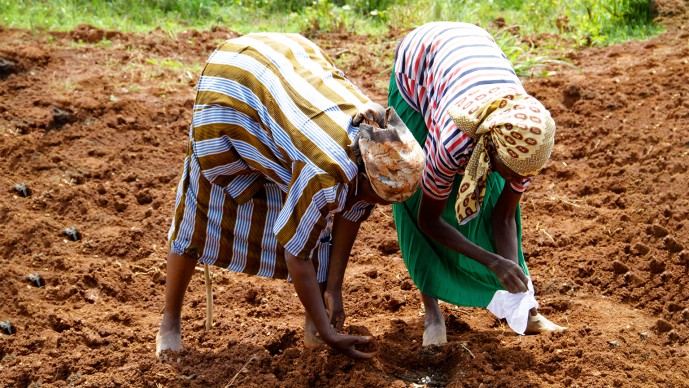Tools and Technologies for Broad-Scale Pest and Disease Surveillance of Crop Plants in Low-Income Countries (Round 22)

The Opportunity
Farmers in every region of the world struggle to protect their crops from pests and disease. Nowhere is the situation more dire than for farmers in low-income countries. Inconsistent access to crop protection products, inadequate knowledge of best-practice control strategies, and a lack of awareness of pest and disease outbreaks leave most farmers unprepared and ill-equipped to respond effectively. Infestations of plant pests and epidemics of plant diseases can destroy crop yields completely, devastating low-income farming families who depend upon the harvest for their food and livelihoods.
Despite the broad impact of these biotic stresses, few data exist on the true burden of crop pests and diseases for low-income countries. Such data are logistically challenging and expensive to obtain through traditional survey methods. Thus, comprehensive, real-time measures of what pests and disease are present, where, and to what severity are severely lacking. Emerging research in data science, engineering, biology, chemistry, computer science, telecommunications and other relevant fields presents an opportunity for a step-change in crop pest and disease surveillance for low-income countries and around the world.
The Challenge
The goal of this topic is to solicit innovative tools and technologies for crop pests and disease surveillance over large geographic regions in low-income countries. We are looking for tools and approaches that have the potential to transform crop pest and disease surveillance globally, with a focus on low-income countries. Ideas that result in increased coverage of geographic area will be prioritized over ideas that increase diagnostic accuracy. Ideas that are applicable or adaptable to multiple crops and diseases/pests will be prioritized over ideas that are specific to only one crop or pathogen. Because we are focused on low-income countries, successful proposals will take into account small-scale, difficult-to-reach, intercropped farming systems with multiple pests and diseases. Farmer-facing applications must be able to integrate into country-level extension services (no single-disease based apps) and must be able to function without requiring a smart phone or reliable internet connectivity. Successful proposals will address data requirements and plans for data acquisition. Preliminary data is not required, but proposals should clearly demonstrate how the idea is an innovative leap in progress from current practices with the potential to be transformative at scale.
To be considered, proposals must closely align with the goals of the foundation's Agricultural Development team. As such, we are looking for proposals that:
- Offer an innovative and transformative solution for surveillance and early detection of crop pests and diseases;
- Offer potential for dramatic cost reductions or increases in efficiency or precision in data collection compared to current strategies;
- Be amenable to integration into a national or regional pest and disease surveillance and response system for crop plants;
- Have potential applicability to at least two of the following crops: maize, wheat, rice, millet, sorghum, cassava, sweet potatoes, yams, bananas, beans, cowpeas, chickpeas, and groundnuts;
- Convey a clear potential for achieving data collection at broad geographic scale.
A few examples of the many possible examples to be considered include:
- Multidisciplinary approaches that leverage emerging research in data science, engineering, biology, chemistry, computer science, telecommunications and other relevant fields;
- Phone-based technologies (Please note: proposals using image analysis strategies must clearly show novel improvement over existing technologies either in integration of diverse data or algorithmic approaches, must address more than one crop and/or disease, and must clearly state the data requirements and achieved or target accuracy);
- Novel sensor-based strategies affordable to low-income country users;
- Approaches that leverage "passive" big data sources (remote sensing, crowd-sourced data, online content, social media, call center records, and other non-traditional data sources) and machine learning/artificial intelligence;
- Other applications not highlighted here.
We will not consider funding for:
- Incremental improvements in our knowledge or application of current pest and disease surveillance strategies;
- Ideas that are not directly relevant to agricultural systems in low-income countries;
- Ideas that are not applicable to the following crops: maize, wheat, rice, millet, sorghum, cassava, sweet potatoes, yams, bananas, beans, cowpeas, chickpeas, and groundnuts;
- Transfer of existing technology to a new system without innovative modification;
- Proposals that focus solely on scaling up or delivery of existing technologies;
- Proposals that focus solely on one-directional extension services to demonstrate or advertise existing technologies without data collection;
- Proposals that focus solely on abiotic stresses (e.g., drought, heat, etc.).
- Proposals that focus solely on modeling of existing data;
- Devices or approaches focused on diagnostic capability for only one pest or disease;
- Proposals focused on post-harvest pests or diseases (e.g. mycotoxins);
- Applications based on image analysis that diagnose a single pest or disease.